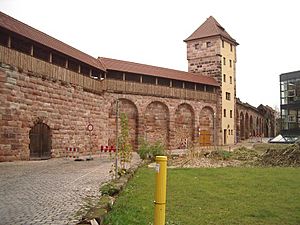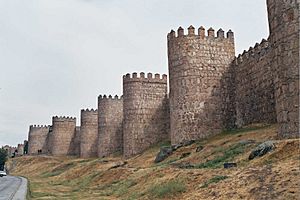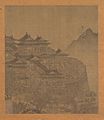Defensive wall facts for kids


A defensive wall is a strong barrier built to protect a place from attackers. Imagine a giant shield around a city! For thousands of years, people used these walls to keep their towns and cities safe. They are often called city walls or town walls.
Some walls were huge, like the Great Wall of China or Hadrian's Wall. These didn't just protect one city; they guarded entire regions or marked borders between lands. Besides keeping enemies out, these walls also showed how important and independent a community was. They were a symbol of strength!
Contents
Why Were Walls Built?
Walls were built for many reasons, mainly to protect people and their homes.
Protection from Attackers
The main reason for building walls was defense. In ancient and medieval times, cities were often attacked by armies or raiders. A strong wall made it very hard for enemies to get in. Soldiers could stand on top of the walls and shoot arrows or throw stones at anyone trying to break through.
Showing Power and Wealth
Building a huge wall was a massive project. It took a lot of people, time, and money. So, a city with strong, tall walls showed everyone how powerful and wealthy it was. It was a way to say, "We are strong, and we can protect ourselves!"
Controlling Who Comes In and Out
Walls also helped control who entered and left a city. They usually had gates that could be closed at night or during an attack. This helped keep out unwanted visitors and collect taxes from traders bringing goods into the city.
How Were Walls Built?
Early defensive walls were often made from earth and wood. Over time, people learned to use stronger materials like stone and brick.
Materials Used
- Stone: Many famous walls, like those in Europe and China, were built with large stones. These were very strong and lasted a long time.
- Brick: In some areas, especially where stone was scarce, bricks were used. These were often baked clay bricks, making them very durable.
- Earth and Wood: Simpler, older walls might have been made from packed earth, sometimes reinforced with wooden posts.
Parts of a Defensive Wall
A typical defensive wall wasn't just a flat barrier. It often had several important parts:
- Towers: These were tall structures built into the wall, often at corners or along straight sections. They gave defenders a better view and a good position to shoot from.
- Gatehouses: These were strong, often complex, structures built around the gates. They were the most vulnerable points, so they were heavily fortified.
- Moats: Sometimes, a ditch filled with water (a moat) was dug around the wall. This made it even harder for attackers to reach the wall.
- Battlements: These are the jagged tops of walls, with gaps (crenels) for shooting and solid parts (merlons) for protection.
Famous Defensive Walls
Many defensive walls around the world are still standing today, telling stories of the past.
The Great Wall of China
The Great Wall of China is one of the most famous walls ever built. It's not just one wall but a series of walls and fortifications built over many centuries. It was meant to protect China from invaders from the north.
Hadrian's Wall
In England, Hadrian's Wall was built by the Romans to mark the northern border of their empire and protect it from tribes to the north.
City Walls of Europe
Many European cities, like Nuremberg in Germany and Ávila in Spain, still have impressive medieval city walls. These walls often surround the old parts of the city and are popular tourist attractions today.
Walls Today
While large city walls are not built for defense anymore, the idea of a defensive barrier still exists. Modern buildings, like some police stations or important government sites, might have strong, fortified walls for security.
Images for kids
-
9th century BC relief of an Assyrian attack on a walled town
-
The lakeside wall of the Yueyang Tower, Yuan dynasty
-
Remains of a defensive wall of Prince Qin Mansion, a citadel within Xi'an
-
The Stone City is a wall in Nanjing dated to the Six Dynasties (220~589). Almost all of the original city is gone, but portions of the city wall remain. Not to be confused with the City Wall of Nanjing.
-
Multiple barbicans of Tongji Gate, Nanjing
-
Porte St. Louis, part of Ramparts of Quebec City, the only remaining fortified city walls in North America north of Mexico
-
The defensive walls of Intramuros, the "Walled City" of old Manila, Philippines
-
Lugo's Roman walls, Galicia, Spain, a UNESCO World Heritage Site
See also
 In Spanish: Muralla para niños
In Spanish: Muralla para niños

















